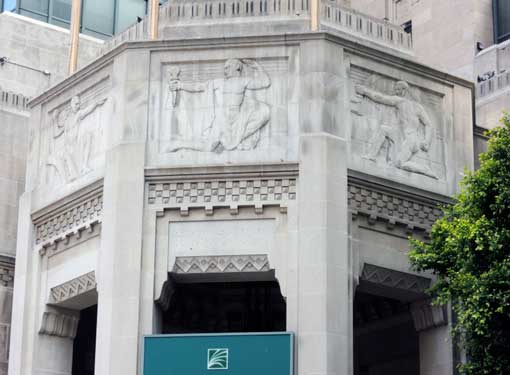Artist:
Merill Gage
Title:
Hydroelectric Power
Year:
1930
Adress:
Bunker Hill Towers
www.publicartinla.com:
Merrell Gage, 1930. Representation of hydro-electric power, limestone. One Bunker Hill (Grand and 5th), CalEdison (California Edison) building.
www.publicartinla.com:
Merrell Gage (1892-1981) was born in Topeka, Kansas. After moving to New York in 1911, he attended the Art Students League, the Henri School and Beaux Arts in addition to being an apprentice with Gutzon Burglum. In 1923, Gage moved to Los Angeles, where he assisted Burt Johnson in executing the sculpture for the Fine Arts Building on Seventh Street. Gage was later commissioned to execute the bas reliefs over the entrances of the Edison Building, which is now One Bunker Hill, and the Los Angeles Times Building. In addition to the bust of Lincoln at the County Courthouse, Gage executed portraits of Lincoln for the Kansas State Capitol, Lincoln Junior High School in Santa Monica and Lincoln College in Lincoln, Nebraska. Gage taught at the Chouinard Art Institute and was on the faculty of the USC Fine Arts Department, which he later chaired.
www.laconservancy.org:
Originally the home of a utility company, the Southern California Edison Company Building was one of the first all-electrically heated and cooled buildings constructed in the western United States.
The fourteen-story, steel-framed building follows a classically inspired Art Deco design. The lower three storiesare of solid limestone, while the upper stories and central tower are faced with buff-colored terra cotta. On the façade, the spandrels contain a cubic Art Deco pattern, repeated in the central tower, lobby floor and elevator ceilings. On the entry façade allegorical figures by sculptor Merrell Gage represent, light, power and hydroelectric energy. In the two-story lobby, classical elements are treated with an Art Deco flavor.
Below the thirty-foot high coffered ceiling, the floor and walls are composed of at least seventeen different types of marble. At the end of the lobby is a mural by Hugo Ballin titled "Power." The exterior greenhouse-like structures were added in the 1980s and the street-level shopping corridor in 1993.
www.omgivning.com:
Inside and out, the building is an Art Deco wonder, with meticulous detailing and grand proportions inspired by classical architecture.
On the entry façade, allegorical bas-relief figures by sculptor Merrell Gage represent light, power and hydroelectric energy. The soaring lobby contains seventeen different varieties of marble and features a mural, 'The Apotheosis of Power,' by the seminal Hugo Ballin.
When the utility company left in 1980, the building was renamed One Bunker Hill. Its character began to suffer from renovations in which, on the upper floors, new acoustic drop-ceiling panels hid historic features overhead, cubicles blocked natural light from streaming through the expansive windows, and carpet obscured original flooring. Outside on the spacious podium patios, the owners installed historically insensitive glass greenhouses.
Merrell Gage, 1930. Representation of hydro-electric power, limestone. One Bunker Hill (Grand and 5th), CalEdison (California Edison) building.
www.publicartinla.com:
Merrell Gage (1892-1981) was born in Topeka, Kansas. After moving to New York in 1911, he attended the Art Students League, the Henri School and Beaux Arts in addition to being an apprentice with Gutzon Burglum. In 1923, Gage moved to Los Angeles, where he assisted Burt Johnson in executing the sculpture for the Fine Arts Building on Seventh Street. Gage was later commissioned to execute the bas reliefs over the entrances of the Edison Building, which is now One Bunker Hill, and the Los Angeles Times Building. In addition to the bust of Lincoln at the County Courthouse, Gage executed portraits of Lincoln for the Kansas State Capitol, Lincoln Junior High School in Santa Monica and Lincoln College in Lincoln, Nebraska. Gage taught at the Chouinard Art Institute and was on the faculty of the USC Fine Arts Department, which he later chaired.
www.laconservancy.org:
Originally the home of a utility company, the Southern California Edison Company Building was one of the first all-electrically heated and cooled buildings constructed in the western United States.
The fourteen-story, steel-framed building follows a classically inspired Art Deco design. The lower three storiesare of solid limestone, while the upper stories and central tower are faced with buff-colored terra cotta. On the façade, the spandrels contain a cubic Art Deco pattern, repeated in the central tower, lobby floor and elevator ceilings. On the entry façade allegorical figures by sculptor Merrell Gage represent, light, power and hydroelectric energy. In the two-story lobby, classical elements are treated with an Art Deco flavor.
Below the thirty-foot high coffered ceiling, the floor and walls are composed of at least seventeen different types of marble. At the end of the lobby is a mural by Hugo Ballin titled "Power." The exterior greenhouse-like structures were added in the 1980s and the street-level shopping corridor in 1993.
www.omgivning.com:
Inside and out, the building is an Art Deco wonder, with meticulous detailing and grand proportions inspired by classical architecture.
On the entry façade, allegorical bas-relief figures by sculptor Merrell Gage represent light, power and hydroelectric energy. The soaring lobby contains seventeen different varieties of marble and features a mural, 'The Apotheosis of Power,' by the seminal Hugo Ballin.
When the utility company left in 1980, the building was renamed One Bunker Hill. Its character began to suffer from renovations in which, on the upper floors, new acoustic drop-ceiling panels hid historic features overhead, cubicles blocked natural light from streaming through the expansive windows, and carpet obscured original flooring. Outside on the spacious podium patios, the owners installed historically insensitive glass greenhouses.



